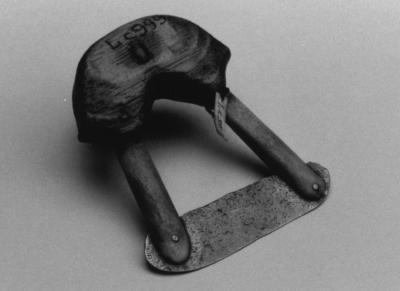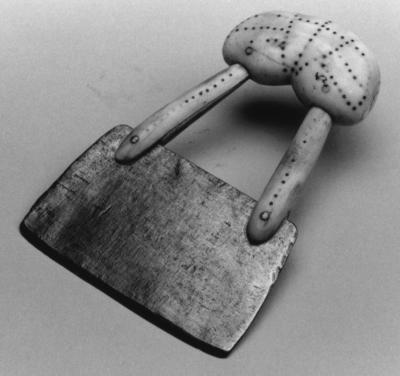Knives from Greenland
Knives from Greenland are almost unnoticed, even though these are also a source of inspiration for contemporary knife makers.
The knives can be split in female- and male-knives, the best known of these 2 is undoubtedly the female-knife - the ulu.
Important tools
The most important tools for the Inuit through time has without doubt been the knife and the needle. The knife for flensing the prey and treating the hides, and the needle for sewing the clothes and the footwear, that could withstand the extreme climate in the Inuit area.
The tools were made from different materials, stone for the knife blades, and filed splinters of bone was turned into needles.
Therefore metal and metal tools was among the most desired commodities when the Inuit people first got in contact with the Europeans.
The ulu - the woman's knife
The ulu, the half-moon shaped knife, is an example of a tool for which the function has dictated the shape, and therefore this tool has been invented several places independent of each other.
It is known from the entire arctic area, and furthermore there is very little difference between the flint scrapers from the Danish stone age and the first ulu’s, or the predecessor, in Greenland.
A piece of chipped stone without a handle, presumably a piece of leather has been used to hold the stone and protect the fingers.
Later on the upper edge of the "blade" has been fixed to a piece of bone or wood, serving as a handle.
Probably driven by a desire to obtain better control with the tool, this has gradually evolved so that you have a "stalk", that increase the distance between the handle and the edge.
The ulu can still be found in every home in Greenland, and it’s used as a universal tool on top of the original function: flensing and cutting up the prey and scraping the hides. Among other things it’s used for making the beautiful coloured leather embroidery - avittat - which can be found on the national costume, leather bags etc., made up by tiny, coloured leather strips cut out and sewn in complicated geometric patterns.
The forming of the stalk, blade and handle have evolved differently in Greenland, so you can distinguish 3 different types, the West Greenland type, the Thule- or polar Eskimo type and finally the East Greenland ulu, or sakkeq as it is called in the East Greenland dialect.
Originally the blades for the ulu in all of Greenland was filed from a piece of metal, a worn-out saw blade or an old shovel. This is still the case in Thule and East Greenland, as it has only been possible to have access to factory made ulu-blades in West Greenland, and such can still be bought in every KNI- (Greenland trade) shop at 40-50 dkr. They are fitted with a handle of wood, bone, tooth or reindeer antlers, are sharpened and are then ready for use. The handles are rarely decorated, and if so only when made for souvenirs. The prize of a souvenir ulu is approx. 200-450 dkr. depending on materials and form, and it can be bought everywhere in Greenland. As far as I know there is no production of ready-to-use ulu’s in Greenland, the way you can see it in Alaska and Canada.
West Greenland ulu
West Greenland was the first area in Greenland, that had permanent contact with the Europeans, and among the commodities were factory made ulu-blades, kept in the shape of a pointed oval with a single stalk to fix the handle.
As earlier mentioned, the handle can be made from almost anything from walrus-tooth to plastic, it’s a tool for everyday use, and you can see it in "action" in the local leather sewing workshop or at the flensing of the seals.
Thule Ulu
The polar Eskimo- or Thule-ulu has a more curved shape or maybe almost the same shape as the West Greenland version, but the stalk, often made from brass, splits in two from the handle down towards the blade, where it is riveted onto the blade. The handle often made from narwhal- of walrus-tusk.
East Greenland ulu or sakkeq.
The East Greenland ulu is very different than the 2 versions above, the blade is less curved and more square in the shape. From the handle, that can be both straight or heavily curved, 2 stalks go down to the blade, riveted on the blade. The handle and the stalks can be made from wood or tooth.
As mentioned earlier the Greenland ulu has never been produced in a factory made version, but Elgkniven by Niels Schmidt in Denmark has made some standardised ulu’s, which I have had the opportunity to try. Unfortunately not for the original purpose, flensing of a seal, but I know it works well for this purpose as well. - They also work well for many purposes in the everyday household (chopping parsley and almonds and so on) and for cutting Greenland delicacies like dried meat, mattak (whale skin) and the like, and they are undoubtedly also suited for flensing and working the hides.
As far as I know they are made in several sizes and also in a East Greenland version, - all with a very high finish, and the are very sharp.
In style this is a mixture of the West Greenland- and the Thule-version, although it resembles the latter more as it has a heavily curved blade, however only one stalk riveted onto the blade. The handle is made from oil treated birch-burl and riveted onto the stalk. I don’t know the price, but it is a good, durable and usable ulu, that probably could be used in most parts of Greenland, even though there is a strong and widespread tradition to make this tool yourself.
The men's knives
The men's knives in Greenland can be split into 2 groups - hunting knives and carving knives.
Old knives in high quality.
Apart from a few souvenir knives, often made in very high quality, there is no contemporary tradition for making knives in Greenland, as factory made knives, covering almost every need, has been easily available from the earliest times. It is a shame that the knife maker tradition is almost dead considering the skill with which other handicraft and art is made in Greenland.
I need to mention though, that for personal use, small carving knives and special tools for making art pieces are still produced.
Historic knives
If you go back in history you find excellent knives, often characterised by the lack of iron and the lack of smithing tradition or other ways to work the metal. In earlier days the blade of the hunting knives could be made from for instance narwhal tusk, as this material when its pointed and sharp easily can kill a harpooned seal.
For anyone who needs new inspiration for his knife making, there will be many ideas to find in the Greenland knife making, or rather handle making.
The handles are traditionally made from bone or wood in one piece, or build up from several parts the way you see it in for instance the same knives.
Decoration
Decorations can be either cut out and coloured dot- and line-patterns, or it can be small pieces f bone or figures riveted onto the handle, which apart from the decorative effect also gives a good grip in a wet, cold and greasy hand.
From East Greenland, which have an exquisite tradition for carving, you often find knives with small figures riveted onto the handle showing different prey or creatures from the spiritual world.
The top of the handle often depicts a stylised hind part of a seal. Furthermore the top of the hunting knives have a two-piece strap in thick sealskin with bone pearls and small figures on it, and the function of this is to make it easier to drag the knife from its secured position under the straps on the kayak in order to kill a harpooned animal.
The sheath
The sheath is usually more like a beautifully made cover or case than a sheath usually seen with knives. This type of sheath is normally made from sealskin with or without fur, and onto this is sewn an embroidery of small pieces of leather in a different colour and in a geometric pattern. So you could say this is more of a case in which to keep the knife, as the knives are not carried the way you see it in for instance Scandinavia. The carving knives were often left behind among the other tools, and the hunting knife was firmly fixed under the straps on the kayak, from where it could easily be drawn with the help out the sealskin strap (see above).
Copy of an old knife.
For the time being people at the Greenland National Museum in Nuuk work on a copy of one of these old knives, which have a top like a hind part of a seal. This knife was originally fitted with a blade made from a slate-scale. The intention of this is to sell it as a souvenir.
The new version will have a steel-blade though, and have a sheath in a more modern style. One could hope this will inspire others to start a Greenland production of knives.
Some literature
If anyone fell like taking a closer look at ulus and old Greenland knives, a visit to the National Museum in Copenhagen can be recommended, as the have a very fine and exiting Greenland collection.
Furthermore any library can get the following books: Gustav Holm samlingen ISBN 87 585 0655 - 1, published by Groenlands Landsmuseum, Nationalmuseet and Groenlands Hjemmestyre, or Bodil Kaalund’s book Groenlands kunst, ISBN 87 01 07304 - 4 published by Gyldendal. In both of these books several photos and a lot of inspiration can be found.
Enjoy yourself !
Originally written by: Ole G. Jensen
Manager of the Museum
Ammasalik, Greenland

Woman’s knife - ulu - from the Thule-area

East Greenland woman’s knife - sakkeq.



Modern ulo made by Niels Schmidt, following serious studies of Greenland ulu’s.

Uppermost left modern ulo, uppermost right East Greenland sakkeq.
Lowermost left West Greenland version, lowermost right Thule-ulu.

Different Greenland knives of different age